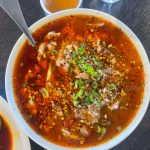
I have not yet been to China. The closest was a town in northern Vietnam so near the border that internet signals were scrambled. A sea of freight trucks filled the streets of Lao Cai, palpable markers of the tight trade relationship between the neighbors. The everywhereness of Chinese tourists throughout Vietnam was a sharp contrast to New Mexico in general and especially Albuquerque, which has yet to be added to the must-visit list of today’s globe-trotting Chinese middle class.
A Chinese coin found near the rail lines in Deming, fragments of rice bowls unearthed near old tracks in Doña Ana County—these are some of the few remaining traces of the Chinese workers who helped build the Rio Grande and Pecos lines that connected New Mexico’s cities to the rest of the United States. Their work on the railroads done, they were not then extended a welcome but effectively chased out of town—sometimes violently. The number who stayed to make lives in Albuquerque was too small to sustain a cultural enclave the likes of Seattle’s or San Francisco’s Chinatown. Growing up here, I learned nothing of the Chinese laundries once clustered where the Silver Gardens apartments and Silver Street Market now sit. Even the second wave of Chinese immigrants was small, and as the twentieth century marched on, racist property covenants restricted not only where Asian citizens could buy property but which neighborhoods they could live in. The success of spots like Fremont’s Fine Foods depended more on serving non-Chinese clientele than on creating a semblance of home. This is partly why you’ll hear people—typically ones relocated from larger, coastal cities—say there’s no good Chinese food in New Mexico.
What is true: In Albuquerque, finding Chinese restaurants—at least the ones whose menus stretch beyond the sweet-and-salty-greasy dishes that won over a first generation of American palates—still requires a little sleuthing, and, for some of us, a willingness to venture into parts of town (and, maybe, parts of the flavor and texture spectrum) that we don’t often visit. These spots are tucked into strip malls next to cannabis dispensaries and hardware stores, obscured by supermarkets and Italian restaurants with more prominent signage. There are no arrows pointing the way, and unlike the old New Chinatown Restaurant, none of these spots greet you with tall signs or China gates. That is part of their charm.
Tasty Noodles and Dumplings

Is there anyone who doesn’t love dumplings? By now, stuffed pillows of dough rival egg rolls as the international gateway to Chinese cuisine. But the popularity of dumplings does not make them “not real Chinese food.” Dumplings and noodles first entered Chinese literature in the third century, via Shu Xi’s “Rhapsody on Pasta”—which is exactly what it sounds like. The poem not only waxes on when dumplings are best eaten—in spring, “when yin and yang begin to converge”—but describes how the aromas wafting from the steamer arouse the hunger and desire of everyone who passes by.
At Tasty Noodles and Dumplings, you can take your dumplings in many ways: There are pan-fried pork scallion buns (sheng jian bao), an easy entry point, if one were needed, for anyone who knows how to enjoy a sausage biscuit. There are the soup dumplings (xiao long bao) that the internet so badly wants you to eat—and I promise, the experience of eating one is a thousand times superior to the experience of watching a video of someone else eating one. There are wontons in chile oil and steamed buns filled with red bean paste. There are steamed vegetable dumplings, unassuming orbs of umami, the light crunch of wood ear mushrooms providing a foil for the napa cabbage. Dipped into a sauce made with black vinegar, they disappear from the table quickly. As Xi wrote, “Plates and trays are no sooner presented than everything is gone.”

But what about the eponymous noodles? At Tasty, hand-pulled noodles are used in Lan-zhou style soups and in Sichuan-inspired dan dan and Chongqing noodles. The classic “secret” Chinese menu is delivered, unasked for, along with the regular menu, and despite the restaurant name, the list of dough-free entrées is long. On one visit, the stir-fried green beans and eggplant, if mild, lent color and beauty to my table; the cumin beef was the highlight of another.
Near 2 pm, as my first long lunch there wound down, a few staff emerged from the kitchen and gathered around a table to eat their own lunch. I contemplated the mural on the wall, a sort of illustrated mirror to the dumpling-making and noodle-slinging across the room, and vowed to try what the cooks eat—only to learn from the server who answered the phone on a weekday afternoon that “sometimes what the cooks make for lunch is not on the menu.”
📍 2325 San Pedro NE, Ste 1E, 505-219-3988
Red Chilli House

Rice is integral to Chinese cuisine, so much so that, according to Fuchsia Dunlop, food in southern China is classed as “rice” or “everything else.” A Chinese friend once instructed me in the practice of serving oneself rice in a small bowl, to be eaten by itself rather than piled with saucy meats or doused with soy sauce. Yet the rice is so rarely a standout at American Chinese restaurants that I was genuinely surprised when I caught the aroma floating off the small bowls of freshly steamed rice that were delivered to my table at Red Chilli House. It was delicious enough to stand alone.
But what about the “everything else”? Let’s talk about the mapo tofu: perfect silken cubes of tofu floating in their mouth-numbing sauce, topped with a sprinkling of fermented black beans and generously dusted with freshly ground, deeply aromatic Sichuan powder. Once full and ostensibly done eating, my friend and I continued reaching our chopsticks into the bowl and plucking out one more morsel. I don’t know if there’s a better version in Albuquerque.
Red Chilli House dispenses with the practice of having a “secret menu,” with all the real Chinese dishes, where items like pork lungs in chile sauce and heartbreaking jelly noodles would be corralled safely out of view of squeamish white people, and has simply dedicated one section of the menu “American Chinese.” If you’re not yet ready to cross over, you can order orange chicken or broccoli beef; or, you can straddle the two menus and order the kung pao chicken—made traditional style, not American, according to proprietor Emily Bai.

Opened in May 2024 at Petroglyph Plaza on Golf Course Road, Red Chilli House is more elegant inside than you might guess on your approach. That’s not to say it’s fancy, but the space is warmly lit and made lively with plants. Inside, it’s possible to forget the vast parking lot just beyond the front doors. If you need to, you can even forget that you’re on the Westside.
📍 8201 Golf Course NW, 505-681-8869
Chopstix

Chopstix is a true hole-in-the-wall: First opened in 2005, the nondescript restaurant (situated, yes, in another of Albuquerque’s infinite strip malls) got a boost from none other than Jackie Chan, who, according to local lore, helped design the mustard greens and pork dish—that still bears his name—while in town filming Spy Next Door. What the dining room lacks in adornments is made up for with the specials papered on the wall in ad hoc fashion—this is where you’ll find some of the “secret” menu items that may or may not appear on the official menu. And like any true hole-in-the-wall, you will find people who praise Chopstix as the epitome of “authentic” alongside ones who say they don’t make the hot and sour soup like they used to.
On my latest visit, it was chilly enough in the dining room that I initially kept my coat on; many customers were picking up sacks of to-go containers. A server told me that dine-in customers dropped from about 80 to 50 percent of business during the pandemic and the numbers have pretty much stayed that way since. But, frills or no frills, it’s so much better to dine in. The glossy pile of fried green beans retains their crunch; the bounteous fried garlic heaped on the Hong Kong shrimp doesn’t get lost at the bottom of a container. If you order those, know that the chef (also the owner) didn’t leave the shells on by accident; rather than being inedible (who ever started that rumor?), the shells, it turns out, lend texture and crunch.

Along with the charm and intrigue of the specials taped to the wall, I appreciate the many iterations of tofu on the menu at Chopstix. I’m partial to the mustard greens with dried tofu, made with a firm, finely chopped tofu that is marinated in house. The house tofu, made from lightly breaded slices of soft tofu, pan-fried and dressed in a mild, slightly sweet sauce, is the sort of dish I’d use to woo a tofu skeptic. Considering the proportion of pork to tofu, even the twice-cooked pork could be considered a demitarian dish.
While far from having made my way through the entire menu at Chopstix—I can’t speak to the hot and sour soup or the General Tso’s chicken—I know enough to know that I will be back.
📍 6001 Lomas NE, Ste L, 505-268-8777








